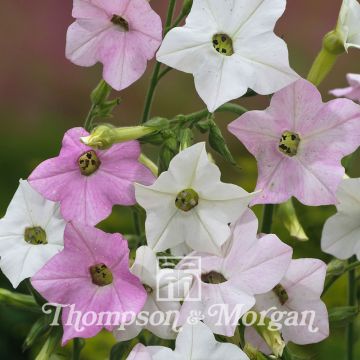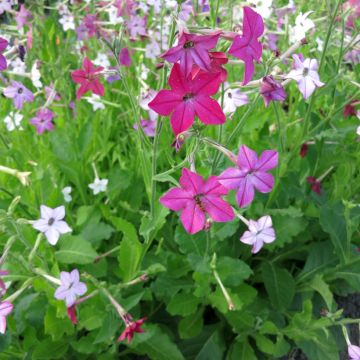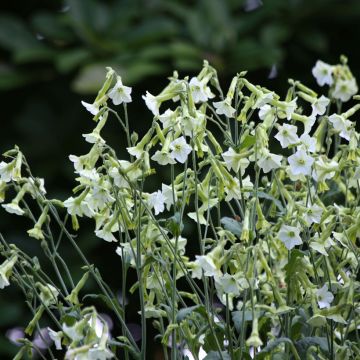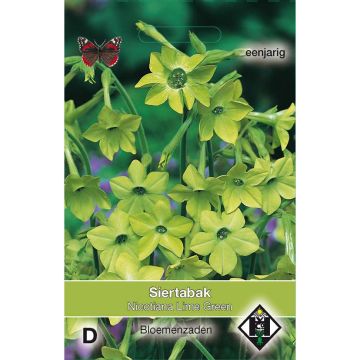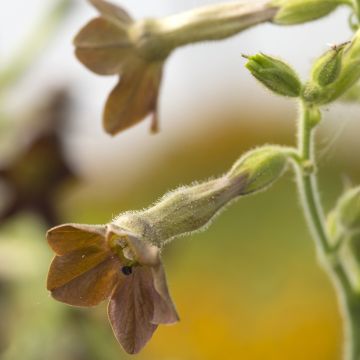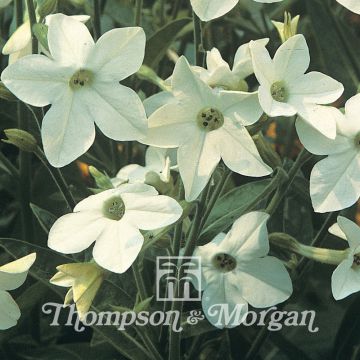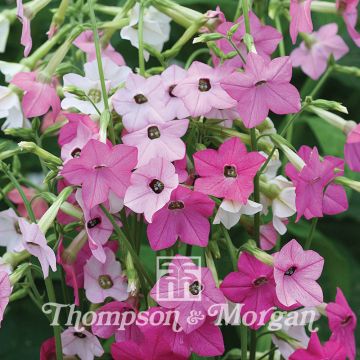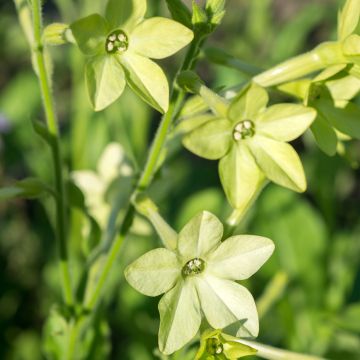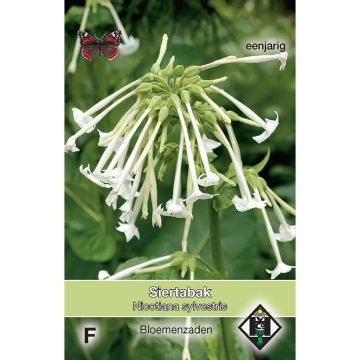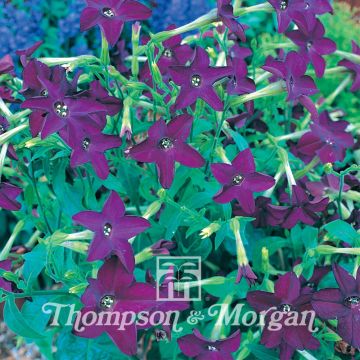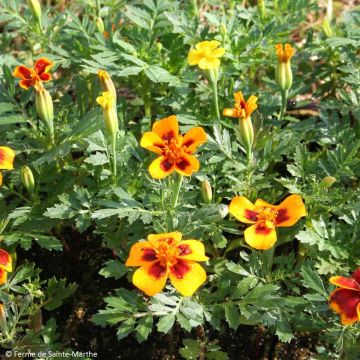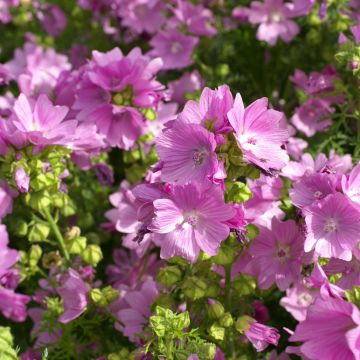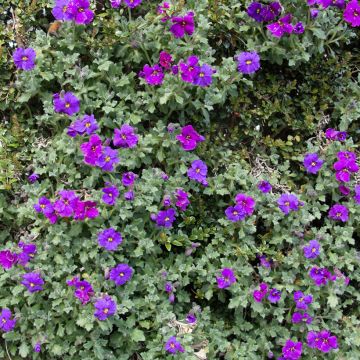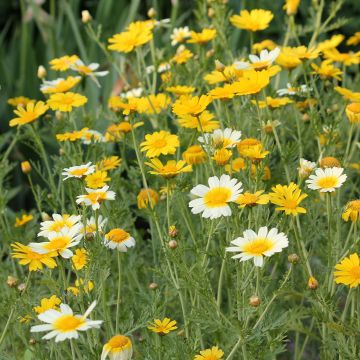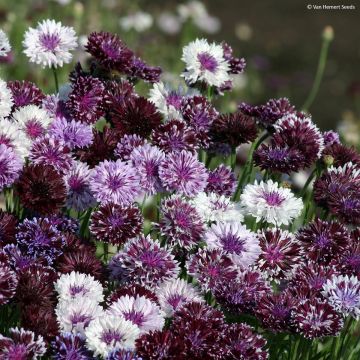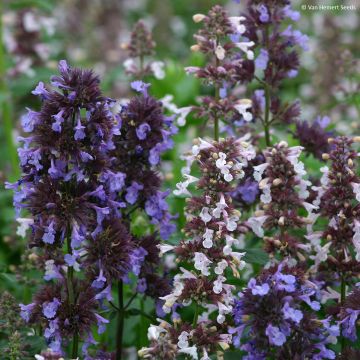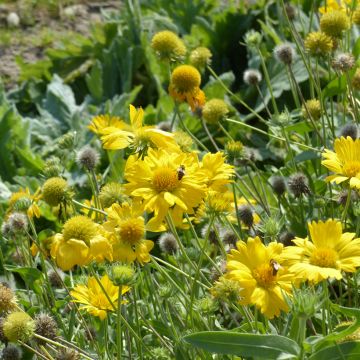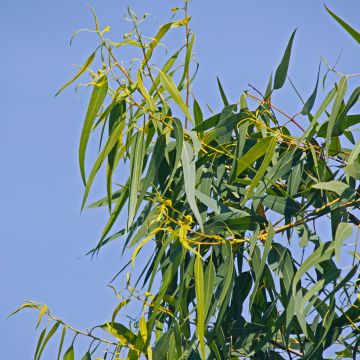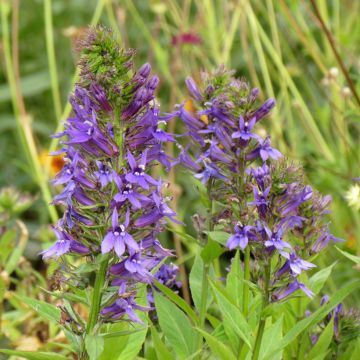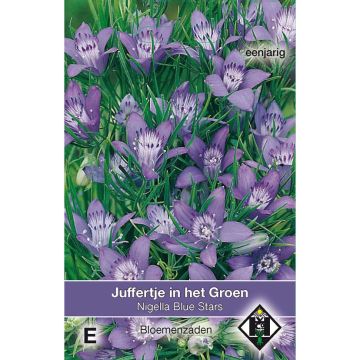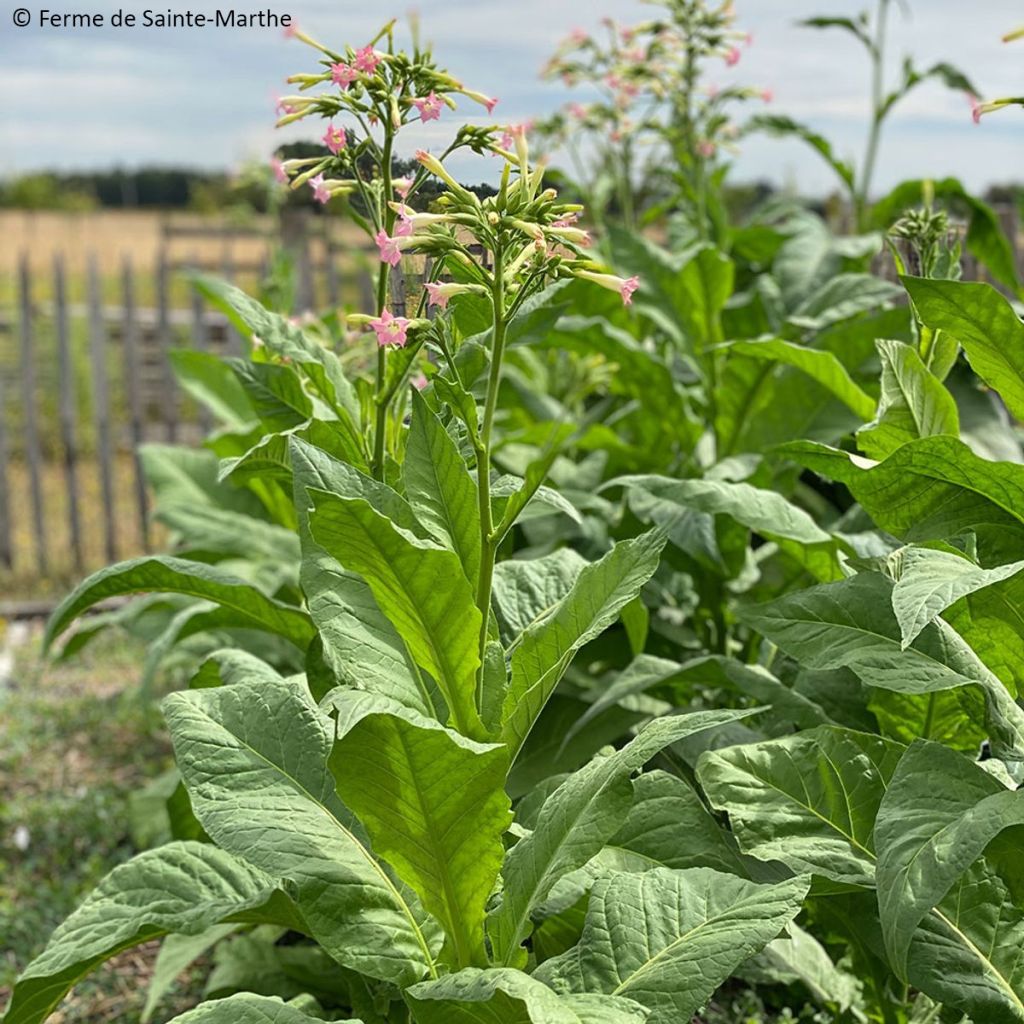

Tabac Gold Leaf Orinoco Bio - Ferme de Sainte Marthe - Nicotiana tabacum
Nicotiana tabacum 'Gold Leaf Orinoco'
Nicotiana tabacum Gold Leaf Orinoco
Tobacco, Cultivated Tobacco, Common Tobacco
This item cannot be shipped to the selected country
Dispatch by letter from €3.90
More information
Schedule delivery date,
and select date in basket
This plant carries a 6 months recovery warranty
More information
We guarantee the quality of our plants for a full growing cycle, and will replace at our expense any plant that fails to recover under normal climatic and planting conditions.
Seed-only orders are dispatched by sealed envelope. The delivery charge for seed-only orders is €3.90.
Does this plant fit my garden?
Set up your Plantfit profile →
Description
The 'Gold Leaf Orinoco' Tobacco is an ancient variety of cultivated tobacco (in Latin Nicotiana tabacum) that is particularly vigorous, forming a magnificent plant exceeding the size of a man in the space of a year. Its large decorative leaves, of a light green colour, have a pronounced aroma that evokes brown Virginia tobaccos, and the leaves located in the upper part of the plant can contain up to 4% nicotine. The tobacco is sown in March or April, under heated shelter, for planting after the frost. This plant appreciates the sun, rich, fresh, but well-drained soils. The leaves will be harvested from June to September and dried away from the sun.
Originally from the plains located in the humid tropical zones of Central America, extensively cultivated in many warm regions, Nicotiana tabacum is a plant of the Solanaceae family cultivated as an annual for the tobacco industry. The 'Gold Leaf Orinoco' variety (Gold Leaf Orinoco) has been cultivated for generations in Peru and has given rise to all modern varieties of Virginia tobacco. It is a herbaceous plant with a pyramidal shape reaching 2m (7ft) in height when flowering, spreading over 70-80cm (28-32in) in width. It develops a robust, slightly sticky stem, which branches out mainly in the upper part. The leaves, embracing at the base and cordate in shape, can measure up to 60cm (24in) in length by 40cm (16in) in width. They are shiny, of a bright green colour and covered with glandular hairs that make them slightly sticky and fragrant. The flowering, not very decorative, begins in midsummer and continues until early autumn. The inflorescence is a racemose cyme bearing small tubular flowers, with trumpet-shaped and rounded 5-lobed corollas. The flowers are greenish-yellow tinged with pink. This nectariferous flowering attracts butterflies, especially certain sphinx moths. The fruit is a capsule containing numerous small seeds.
Usage: 'Gold Leaf Orinoco' tobacco produces magnificent and highly aromatic plants. Generally, dried tobacco leaves are used for smoking or as an insect repellent. Drying is a process that takes 3 to 8 weeks in the open air and in the shade. It is advisable to take advantage of the end of summer or the beginning of autumn with still warm and dry days and relatively humid cool nights for drying. First, select the leaves located at the base of the plant, which yellow first. They will be bound at the petioles in small bundles of 3 to 5 with a rubber band, each bundle will be hung on a cord. Choose a location that is both shaded (no direct sunlight) and well-ventilated, such as a shed, barn, or well-ventilated garage. Make sure the air is not too dry, possibly close your location during the day and open it at night. The leaves gradually change colour from yellow to orange to brown. Their edge is slightly curved, but they should not be brittle.
Attention, seeds reserved for very experienced gardeners who are used to sowing very fine seeds. These seeds are as fine as dust, barely visible to the naked eye.
Report an error about the product description
Flowering
Foliage
Plant habit
Botanical data
Nicotiana
tabacum
Gold Leaf Orinoco
Solanaceae
Tobacco, Cultivated Tobacco, Common Tobacco
Cultivar or hybrid
Other Tobacco seeds
Planting and care
Sowing:
Sow tobacco seeds in March-April in pots or trays filled with moist compost and cover with a light sprinkle of vermiculite. Place in a propagator or enclose them in a polythene bag and put it in a warm place. Maintain a temperature of 18 to 20 °C. Keep in the light, as this promotes germination. Keep the surface of the compost moist, but not waterlogged; germination usually takes 7 to 21 days.
When the plants are sufficiently developed (4 to 5 leaves), transplant them into 7.5cm (3in) pots or trays. Acclimatize the plants to cooler conditions for a few weeks before placing them outside after all risk of frost, at a distance of 80cm (32in) apart.
Cultivation:
Tobacco plants thrive in rich, deep, and slightly moist soils. They enjoy the sun, but excessive exposure can damage their foliage. They also grow well in partial shade. In mild climates, these plants often become perennials. They readily self-seed in the garden, appearing in various locations.
Sowing period
Intended location
This item has not been reviewed yet - be the first to leave a review about it.
Flower seeds
Haven't found what you were looking for?
Hardiness is the lowest winter temperature a plant can endure without suffering serious damage or even dying. However, hardiness is affected by location (a sheltered area, such as a patio), protection (winter cover) and soil type (hardiness is improved by well-drained soil).

Photo Sharing Terms & Conditions
In order to encourage gardeners to interact and share their experiences, Promesse de fleurs offers various media enabling content to be uploaded onto its Site - in particular via the ‘Photo sharing’ module.
The User agrees to refrain from:
- Posting any content that is illegal, prejudicial, insulting, racist, inciteful to hatred, revisionist, contrary to public decency, that infringes on privacy or on the privacy rights of third parties, in particular the publicity rights of persons and goods, intellectual property rights, or the right to privacy.
- Submitting content on behalf of a third party;
- Impersonate the identity of a third party and/or publish any personal information about a third party;
In general, the User undertakes to refrain from any unethical behaviour.
All Content (in particular text, comments, files, images, photos, videos, creative works, etc.), which may be subject to property or intellectual property rights, image or other private rights, shall remain the property of the User, subject to the limited rights granted by the terms of the licence granted by Promesse de fleurs as stated below. Users are at liberty to publish or not to publish such Content on the Site, notably via the ‘Photo Sharing’ facility, and accept that this Content shall be made public and freely accessible, notably on the Internet.
Users further acknowledge, undertake to have ,and guarantee that they hold all necessary rights and permissions to publish such material on the Site, in particular with regard to the legislation in force pertaining to any privacy, property, intellectual property, image, or contractual rights, or rights of any other nature. By publishing such Content on the Site, Users acknowledge accepting full liability as publishers of the Content within the meaning of the law, and grant Promesse de fleurs, free of charge, an inclusive, worldwide licence for the said Content for the entire duration of its publication, including all reproduction, representation, up/downloading, displaying, performing, transmission, and storage rights.
Users also grant permission for their name to be linked to the Content and accept that this link may not always be made available.
By engaging in posting material, Users consent to their Content becoming automatically accessible on the Internet, in particular on other sites and/or blogs and/or web pages of the Promesse de fleurs site, including in particular social pages and the Promesse de fleurs catalogue.
Users may secure the removal of entrusted content free of charge by issuing a simple request via our contact form.
The flowering period indicated on our website applies to countries and regions located in USDA zone 8 (France, the United Kingdom, Ireland, the Netherlands, etc.)
It will vary according to where you live:
- In zones 9 to 10 (Italy, Spain, Greece, etc.), flowering will occur about 2 to 4 weeks earlier.
- In zones 6 to 7 (Germany, Poland, Slovenia, and lower mountainous regions), flowering will be delayed by 2 to 3 weeks.
- In zone 5 (Central Europe, Scandinavia), blooming will be delayed by 3 to 5 weeks.
In temperate climates, pruning of spring-flowering shrubs (forsythia, spireas, etc.) should be done just after flowering.
Pruning of summer-flowering shrubs (Indian Lilac, Perovskia, etc.) can be done in winter or spring.
In cold regions as well as with frost-sensitive plants, avoid pruning too early when severe frosts may still occur.
The planting period indicated on our website applies to countries and regions located in USDA zone 8 (France, United Kingdom, Ireland, Netherlands).
It will vary according to where you live:
- In Mediterranean zones (Marseille, Madrid, Milan, etc.), autumn and winter are the best planting periods.
- In continental zones (Strasbourg, Munich, Vienna, etc.), delay planting by 2 to 3 weeks in spring and bring it forward by 2 to 4 weeks in autumn.
- In mountainous regions (the Alps, Pyrenees, Carpathians, etc.), it is best to plant in late spring (May-June) or late summer (August-September).
The harvesting period indicated on our website applies to countries and regions in USDA zone 8 (France, England, Ireland, the Netherlands).
In colder areas (Scandinavia, Poland, Austria...) fruit and vegetable harvests are likely to be delayed by 3-4 weeks.
In warmer areas (Italy, Spain, Greece, etc.), harvesting will probably take place earlier, depending on weather conditions.
The sowing periods indicated on our website apply to countries and regions within USDA Zone 8 (France, UK, Ireland, Netherlands).
In colder areas (Scandinavia, Poland, Austria...), delay any outdoor sowing by 3-4 weeks, or sow under glass.
In warmer climes (Italy, Spain, Greece, etc.), bring outdoor sowing forward by a few weeks.

































